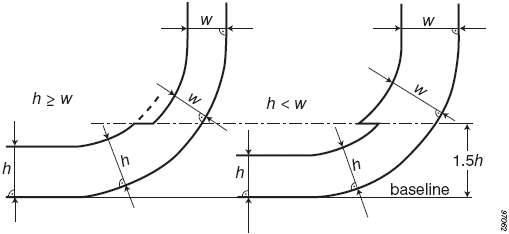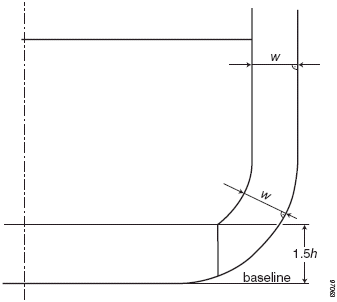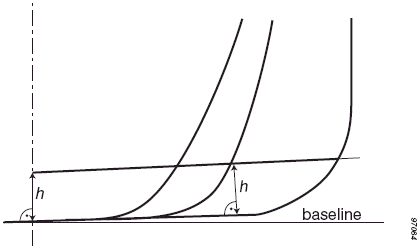1 This regulation shall apply to oil tankers of 600 tonnes deadweight
and above delivered on or after 6 July 1996, as defined in regulation 1.28.6,
as follows:
2 Every oil tanker of 5000 tonnes deadweight and above shall:
| .1 |
in lieu of paragraphs 12 to 15 of regulation 18, as applicable,
comply with the requirements of paragraph 3 of this regulation
unless it is subject to the provisions of paragraphs 4 and 5 of this
regulation; and |
| .2 |
comply, if applicable, with the requirements of regulation 28.6. |
3 The entire cargo tank length shall be protected by ballast tanks or
spaces other than tanks that carry oil as follows:
| .1 |
Wing tanks or spaces |
| |
Wing tanks or spaces shall extend either for the full depth of the
ship's side or from the top of the double bottom to the
uppermost deck, disregarding a rounded gunwale where fitted. They shall be arranged such that the cargo tanks are located
inboard of the moulded line of the side shell plating nowhere
less than the distance w, which, as shown in figure 1, is
measured at any cross-section at right angles to the side shell, as
specified below: |
| |
|
w = 0.5 +  (m) or (m) or |
| |
|
w = 2.0 m, whichever is the lesser. |
| |
|
The minimum value of w = 1.0 m. |
| .2 |
Double bottom tanks or spaces |
| |
At any cross-section, the depth of each double bottom tank or
space shall be such that the distance h between the bottom of the
cargo tanks and the moulded line of the bottom shell plating
measured at right angles to the bottom shell plating as shown in
figure 1 is not less than specified below: |
| |
|
h = B/15 (m) or |
| |
|
h = 2.0 m, whichever is the lesser. |
| |
The minimum value of h = 1.0 m. |
| .3 |
Turn of the bilge area or at locations without a clearly defined
turn of the bilge |
| |
When the distances h and w are different, the distance w shall
have preference at levels exceeding 1.5h above the baseline as
shown in figure 1. |

Figure 1 – Cargo tank boundary lines for the purpose of paragraph 3
| .4 |
The aggregate capacity of ballast tanks |
| |
On crude oil tankers of 20,000 tonnes deadweight and above
and product carriers of 30,000 tonnes deadweight and above,
the aggregate capacity of wing tanks, double bottom tanks,
forepeak tanks and after peak tanks shall not be less than the
capacity of segregated ballast tanks necessary to meet the
requirements of regulation 18 of this Annex. Wing tanks or
spaces and double bottom tanks used to meet the requirements
of regulation 18 shall be located as uniformly as practicable along
the cargo tank length. Additional segregated ballast capacity
provided for reducing longitudinal hull girder bending stress,
trim, etc. may be located anywhere within the ship. |
| .5 |
Suction wells in cargo tanks |
| |
Suction wells in cargo tanks may protrude into the double
bottom below the boundary line defined by the distance h provided that such wells are as small as practicable and the
distance between the well bottom and bottom shell plating is
not less than 0.5h. |
| .6 |
Ballast and cargo piping |
| |
Ballast piping and other piping such as sounding and vent piping
to ballast tanks shall not pass through cargo tanks. Cargo piping
and similar piping to cargo tanks shall not pass through ballast
tanks. Exemptions to this requirement may be granted for short
lengths of piping, provided that they are completely welded or
equivalent. |
4 The following applies for double bottom tanks or spaces:
| .1 |
Double bottom tanks or spaces as required by paragraph 3.2 of
this regulation may be dispensed with, provided that the design
of the tanker is such that the cargo and vapour pressure exerted
on the bottom shell plating forming a single boundary between
the cargo and the sea does not exceed the external hydrostatic
water pressure, as expressed by the following formula: |
| |
|
f × hc × ρc × g + p ≤ dn × ρs × g |
| |
where: |
|
| |
hc |
= |
height of cargo in contact with the bottom shell plating
in metres |
| |
ρc |
= |
maximum cargo density in kg/m3 |
| |
dn |
= |
minimum operating draught under any expected
loading condition in metres |
| |
ρs |
= |
density of seawater in kg/m3 |
| |
p |
= |
maximum set pressure above atmospheric pressure
(gauge pressure) of pressure/vacuum valve provided for
the cargo tank in pascals |
| |
f |
= |
safety factor = 1.1 |
| |
g |
= |
standard acceleration of gravity (9.81 m/s2). |
| .2 |
Any horizontal partition necessary to fulfil the above requirements
shall be located at a height not less than B/6 or 6 m,
whichever is the lesser, but not more than 0.6D, above the
baseline where D is the moulded depth amidships. |
| .3 |
The location of wing tanks or spaces shall be as defined in
paragraph 3.1 of this regulation except that, below a level 1.5h above the baseline where h is as defined in paragraph 3.2 of this
regulation, the cargo tank boundary line may be vertical down
to the bottom plating, as shown in figure 2. |

Figure 2 – Cargo tank boundary lines for the purpose of paragraph 4
5 Other methods of design and construction of oil tankers may also be
accepted as alternatives to the requirements prescribed in paragraph 3 of this
regulation, provided that such methods ensure at least the same level of
protection against oil pollution in the event of collision or stranding and are
approved in principle by the Marine Environment Protection Committee
based on guidelines developed by the Organization.*
6 Every oil tanker of less than 5,000 tonnes deadweight shall comply
with paragraphs 3 and 4 of this regulation, or shall:
| .1 |
at least be fitted with double bottom tanks or spaces having such
a depth that the distance h specified in paragraph 3.2 of this
regulation complies with the following: |
| |
|
h = B/15 (m) |
| |
with a minimum value of h = 0.76 m; |
| |
in the turn of the bilge area and at locations without a clearly
defined turn of the bilge, the cargo tank boundary line shall run
parallel to the line of the midship flat bottom as shown in
figure 3; and |
| .2 |
be provided with cargo tanks so arranged that the capacity of
each cargo tank does not exceed 700 m3 unless wing tanks or
spaces are arranged in accordance with paragraph 3.1 of this
regulation, complying with the following: |
| |
|
w = 0.4 +  (m) (m) |
| |
with a minimum value of w = 0.76 m. |

Figure 3 – Cargo tank boundary lines for the purpose of paragraph 6
7 Oil shall not be carried in any space extending forward of a collision
bulkhead located in accordance with regulation II-1/11 of the International
Convention for the Safety of Life at Sea, 1974, as amended. An oil tanker
that is not required to have a collision bulkhead in accordance with that
regulation shall not carry oil in any space extending forward of the
transverse plane perpendicular to the centreline that is located as if it were a
collision bulkhead located in accordance with that regulation.
8 In approving the design and construction of oil tankers to be built in
accordance with the provisions of this regulation, Administrations shall have
due regard to the general safety aspects, including the need for the
maintenance and inspections of wing and double bottom tanks or spaces.
|
 (m) or
(m) or 

